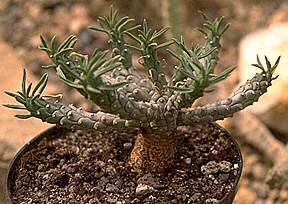
Distribution: Rep. South Africa (North West, Free State, Northern Cape), Botswana, Zimbabwe (?); in deep sandy soils, in the savannah; at 900 to 1372 m altitude.
Description: Dwarf euphorbia, 5 to 6 cm high, with 1 to 3 underground stems, these up to 10 cm long, 5 to 20 mm in diameter, producing 6 to 9 branches at their apex, main root more or less cylindrical, 12 to 25 mm in diameter, tapering at the base into a thin taproot of up to 2 m length; branches ultimately deciduous, 4 to 6 cm long, 25 to 40 (and more) mm in diameter, cylindrical, tuberculate, tubercles 1 mm prominent; spineless; leaves rudimentary, soon deciduous; cyathia solitary at the apices of stems and branches, peduncles 5 to 8 mm long, involucre cup-shaped, 4 mm deep, 3 mm in diameter, 5 glands, these elliptic, 2 to 2.5 mm across, outer margin entire or with 2 to 4 processes, these up to 1 mm long, teeth-like, greenish white, slightly red spotted. Similar species: E. bergii White, Dyer & Sloane, these without thickened central body.
Cultivation: Sensitive species, keep dry during winter, minimum temperature 6 °C; propagation by seeds and cuttings (two-step-cutting-method).
Literature